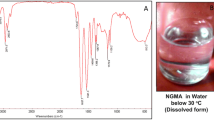Abstract
Purpose
To determine whether bone marrow-derived progenitor cells can be stimulated by inflammatory mediators and play a role in corneal wound healing following alkali injury.
Methods
Sixty rabbits were divided into two groups( Group I and Group II). Group I served as a bone marrow-suppression model, and received 200 mg/kg cyclophosphamide. Corneal alkali injury was created in one eye of each rabbit in each group; the other eye served as control. Three days after corneal burn, inflammatory cells in peripheral blood were counted. At the end of 4 weeks follow-up, corneas of all rabbits were subjected to histochemical examination to assess infiltrated CD34 and C-kit positive cells. Clinical outcome was determined at the end of 4 weeks.
Results
Cyclophosphamide suppressed bone marrow function in Group I by reducing cellularity by more than 30% and neutrophil distribution by 3.18 ± 1.83%. The number of bone marrow hematopoietic and mesenchymal progenitor cells were all suppressed by cyclophophamide, as demonstrated by statistically significant differences between Group I and Group II of CD34+ cells (t = −21.62, P < 0.01) and C-Kit cells (t = −21.62, P < 0.01). Fewer inflammatory cells were released into circulation in Group I (14.42 ± 5.70%) than in Group II (44.36 ± 8.64%). Clinical observation revealed that Group II rabbits had much greater reepithelization (t = 6.999, P < 0.01) and clearer corneas (X 2 = 4.417, P < 0.01) than Group I.
Conclusions
Corneal alkali injury is a stimulus that induces a rapid bone marrow reaction to release not only inflammatory cells but also progenitor cells into circulation. Migrated bone marrow-derived progenitor cells can home to local sites to promote wound healing.



Similar content being viewed by others
References
Kao WW, Zhu G, Benza R, Kao CW, Ishizaki M, Wander AH (1996) Appearance of immune cells and expression of MHC II DQ molecule by fibroblasts in alkali-burned corneas. Cornea 15(4):397–408
Sappino AP, Schurch W, Gabbiani G (1990) Differentiation repertoire of fibroblastic cells: Expression of cytoskeletal proteins as marker of phenotypic modulations. Lab Invest 63:144–161
Folkman J (1995) Angiogenesis in cancer, vascular, rheumatoid and other disease. Nat Med 1(1):27–31
Krause DS, Theise ND, Collector MI, Henegariu O, Hwang S, Gardner R, Neutzel S, Sharkis SJ (2001) Multi-organ, multi-lineage engraftment by a single bone marrow-derived stem cell. Cell 105(3):369–377
Mori L, Bellini A, Stacey MA, Schmidt M, Mattoli S (2005) Fibrocytes contribute to the myofibroblast population in wounded skin and originate from the bone marrow. Exp Cell Res 304(1):81–90
Asahara T, Murohara T, Sullivan A, Silver M, van der Zee R, Li T, et al (1997) Isolation of putative stem endothelial cells for angiogenesis. Science 275(5302):964–967
Brazelton TR, Rossi FM, Keshet GI, Blau HM (2000) From marrow to brain: expression of neuronal phenotypes in adult mice. Science 290(5497):1775–1779
Hristov M, Weber C (2004) Endothelial progenitor cells: characterization, pathophysiology, and possible clinical relevance. J Cell Mol Med 8(4):498–508
Conget PA, Minguell JJ (1999) Phenotypical and functional properties of human bone marrow mesenchymal progenitor cells. J Cell Physiol 181(1):67–73
Ye J, Yao K, Kim JC (2006) Mesenchymal stem cell transplantation in a rabbit corneal alkali burn model: engraftment and involvement in wound healing. Eye 20(4):482–490
Burt RK, Traynor AE, Pope R, Schroeder J, Cohen B, Karlin KH, et al (1998) Treatment of autoimmune disease by intense immunosuppressive conditioning and autologous hematopoietic stem cell transplantation. Blood 92(10):3505–3514
Fantes FE, Hanna KD, Waring GO 3rd, Pouliquen Y, Thompson KP, Savoldelli M (1990) Wound healing after excimer laser keratomileusis (photorefractive keratectomy) in monkeys. Arch Ophthalmol 108(5):665–675
Yamada M, Kubo H, Kobayashi S, Ishizawa K, Numasaki M, Ueda S, Suzuki T, Sasaki H (2004) Bone marrow-derived progenitor cells are important for lung repair after lipopolysaccharide-induced lung injury. J Immunol 172(2):1266–1272
Sosne G, Szliter EA, Barrett R, Kernacki KA, Kleinman H, Hazlett LD (2002) Thymosin beta 4 promotes corneal wound healing and decreases inflammation in vivo following alkali injury. Exp Eye Res 74(2):293–299
Sivan-Loukianova E, Awad OA, Stepanovic V, Bickenbach J, Schatteman GC (2003) CD34+ blood cells accelerate vascularization and healing of diabetic mouse skin wounds. J Vasc Res 40(4):368–377
Ishizaki M, Wakamatsu K, Matsunami T, Yamanaka N, Saiga T, Shimizu Y, et al (1994) Dynamics of the expression of cytoskeleton components and adherens molecules by fibroblastic cells in alkali-burned and lacerated corneas. Exp Eye Res 59(5):537–549
Author information
Authors and Affiliations
Corresponding author
Additional information
Authors have no financial interest in any product or concept discussed in article.
Grant: China National Scientific Fund 30500552. Research Fund of Health Bureau of Zhejiang Province, PR China. 2005QN006.
Rights and permissions
About this article
Cite this article
Ye, J., Lee, S.Y., KooK, K.H. et al. Bone marrow-derived progenitor cells promote corneal wound healing following alkali injury. Graefes Arch Clin Exp Ophthalmol 246, 217–222 (2008). https://doi.org/10.1007/s00417-007-0716-0
Received:
Revised:
Accepted:
Published:
Issue Date:
DOI: https://doi.org/10.1007/s00417-007-0716-0




